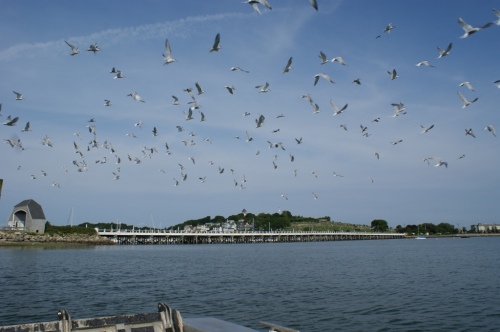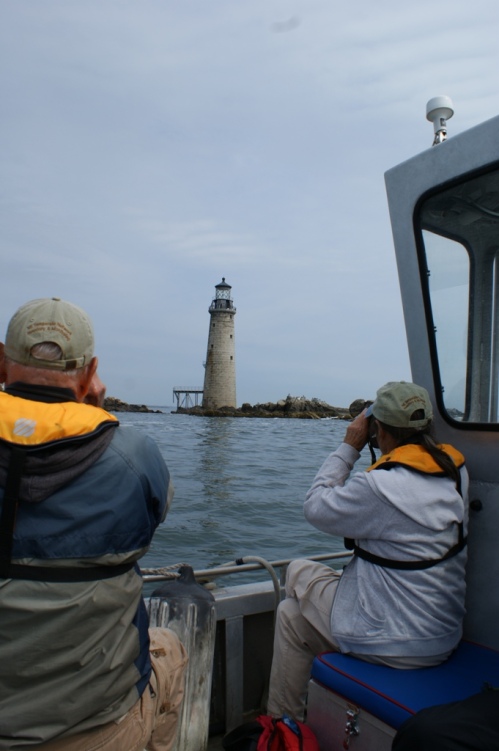Busy week, last week! On May 30thwe had planned to visit Sarah Island to count nests in the wading bird colony located there, but a preliminary boat-based survey around the island indicated that we had already missed our opportunity for this season.

Boat-based survey of Sarah Island (CLT, 5.30.2012).
Many chicks were present in the colony, and some visible egret chicks were already quite large. Visiting a colony when large chicks are present can cause tremendous disturbance with serious consequences. If young are mobile enough to ‘branch’ when scared, you run the risk of young falling from the nest site. Because herons and egrets are altricial and require parental care, any earlier-then-planned exit from the nest can result in abandonment and starvation… needless to say, this is not a scenario we want our survey efforts to produce. Although we would have liked to have included Sarah with the other wading bird sites in the park this year, it will become a priority next May. Boat-based observations did count 87 nesting Double-crested Cormorants on Sarah and ascertain that Great Egrets, Snowy Egrets, Black-crowned Night-Herons, and Glossy Ibis were all present and nesting there.
With a high tide in Hingham Harbor and no herons to survey, we decided to conduct a boat-based survey in search of American Oystercatcher pairs. One pair of AMOY were detected on Button, as well as a pair on Bumpkin and one quiet adult that may have been one half of a pair on Slate. Three pair of AMOY (1 with 2 chicks and 1 with 1 chick) were observed on Sheep Island, along with nesting GREGs, SNEGS, GLIBs, and BCNHs and 13 DCCOs. We also located a pair of AMOY and an extra adult on Hangman. No American Oystercatchers were observed on Langlee, Ragged, Sarah, Grape, or any of the south facing beaches of Peddocks (including Prince’s Head).
We finished our day last Wednesday with a ground based survey of Rainsford Island where we observed 2 pair of territorial American Oystercatchers, one with 2 chicks. We also observed 7 Spotted Sandpiper territories, but did not locate any nests. No terns were active in the area.
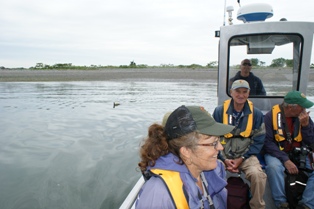
Friendly Mallard chasing the landing craft… (CLT, 5.30.2012).
However, while we were searching the island, Russ was befriended by a very social female Mallard. She apparently became quite besotted with him (with no encouragement on his part) and hopped in and out of the landing craft trying to attract his attention. Upon leaving the island she attempted to follow the boat, swimming along behind and taking short flights to keep up with us… A transplant from the public garden, perhaps?

Boat-based survey of the Outer Islands (CLT, 5.31.2012).
On Thursday, May 31stwe started the day with a boat-based survey in the Outer Islands where we counted 214 eider ducklings accompanied by 153 females.
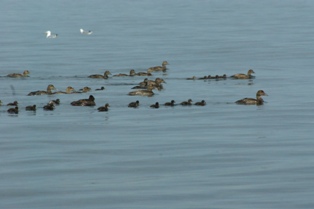
Common Eider flotilla in the Roaring Bulls (CLT, 5.31.2012).
Generally, our highest counts of the season occur in mid-June, so this number may still be rising though everything has generally been a little ahead of schedule this spring… We also observed 3 pairs of American Oystercatchers on Calf Island and 1adult from the pair nesting on Middle Brewster. We did not see the pair previously nesting on the landing beach on Outer Brewster.
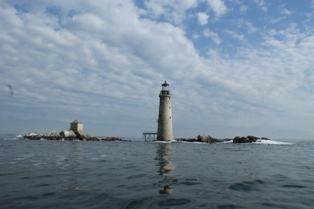
Graves Light (CLT, 5.31.2012).
A ground-based survey of Great Brewster resulted in 2 pair of territorial American Oystercatchers and one Common Eider nest.
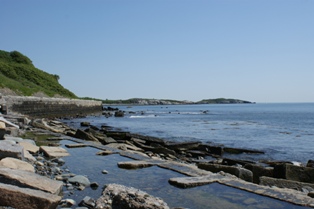
Middle and Outer Brewster, from Great Brewster (CLT, 5.31.2012).
We ended the day with a visit to Lovells where 8 adult Least Terns were observed actively defending the colony site.

Bob S. observing Least Terns on Lovells (CLT, 5.31.2012).
Unfortunately, we also observed a Great Black-backed gull nest with 2 eggs in the same area. One pair of American Oystercatchers were observed loafing in the intertidal are on the west side of the island and 4 Spotted Sandpipers were noted feeding intertidally on the east side. We were also confronted by an adult Killdeer doing her absolute best to convince us that she (with 2 broken wings!) was an easy target

Killdeer doing ‘broken wing’ display, Lovells Island (CLT, 5.31.2012).
and that we shouldn’t waste our time continuing on the path from the beach to the center island that just happened to have her nest, with four perfect eggs, planted right in the middle of it!

Perfect Killdeer nest on Lovells (CLT, 5.31.2012).
Till next week! -Carol
Read Full Post »


